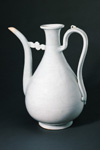|
David Henry Hwang
The platter and ewer
from China remind us that commercialism and globalization have shaped
art and culture long before our own time. The ewer derives its form from
Middle Eastern metalwork. Many such pieces were created between the fourteenth
and sixteenth centuries for export; eventually, items once crafted for
foreign tastes became fashionable within Yuan dynasty China itself. Similarly,
the large size of the platter suggests it was made to sell abroad; significantly,
the design may even represent the linking together of coins. I find these
pieces provocative in light of modern debates which suggest a work is
less "authentic" because it caters to a broad audience-for instance, the
charge by some that the movie Crouching Tiger, Hidden Dragon is inauthentic
by virtue of its appeal to Western audiences. Should these pieces be considered
suspect for the same reason, or might we simply enjoy their aesthetic
beauty?
|
 China, Jiangxi Province
China, Jiangxi Province